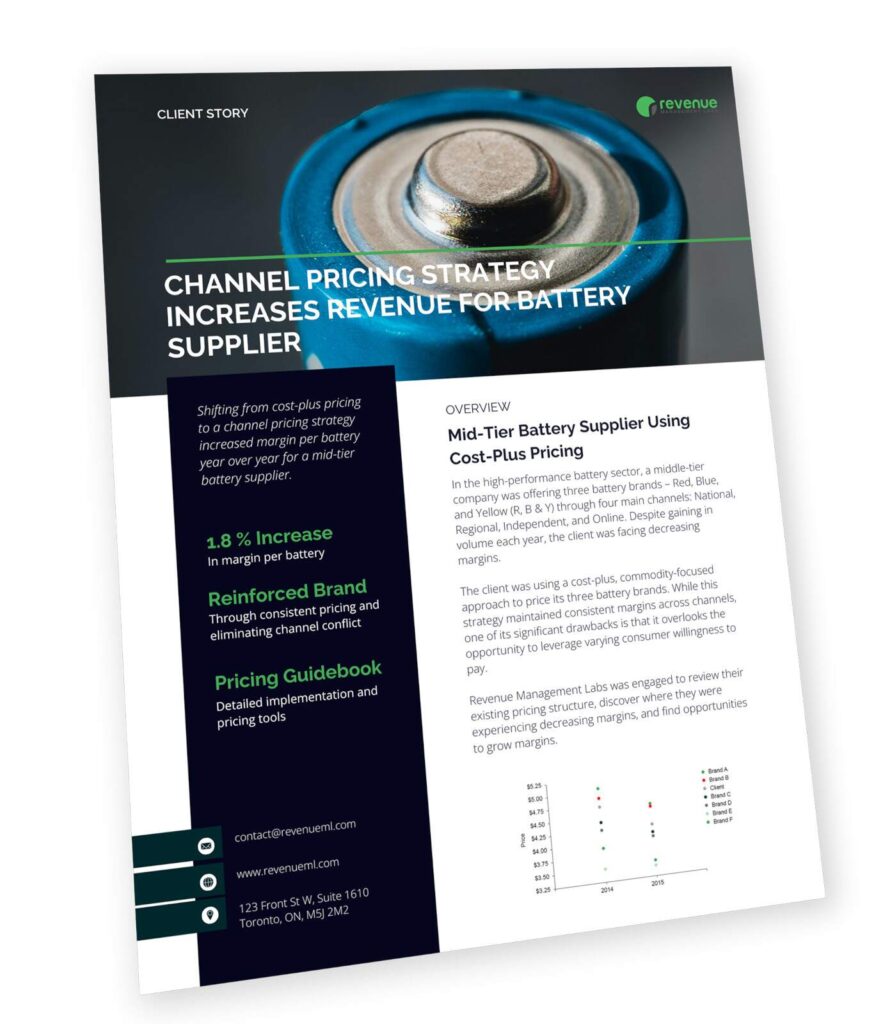Shifting from cost-plus pricing to a channel pricing strategy increased margin per battery year over year for a mid-tier battery supplier.
In the high-performance battery sector, a middle-tier company was offering three battery brands – Red, Blue, and Yellow (R, B & Y) through four main channels: National, Regional, Independent, and Online. Despite gaining in volume each year, the client was facing decreasing margins.
The client was using a cost-plus, commodity-focused approach to price its three battery brands. While this strategy maintained consistent margins across channels, one of its significant drawbacks is that it overlooks the opportunity to leverage varying consumer willingness to pay.
Revenue Management Labs was engaged to review their existing pricing structure, discover where they were experiencing decreasing margins, and find opportunities to grow margins.
The company faced a situation where they experienced volume growth year over year. This expansion is often considered a positive sign for a business, but in the case of the battery supplier, they were also experiencing a shift in channel volume toward lower-margin alternatives. The result was a negative profit mix and decreasing overall margins.
In margin per battery
Through consistent pricing and eliminating channel conflict
Detailed implementation and pricing tools

Review the advanced analytics behind our pricing strategy and the increase in revenue.
Revenue Management Labs developed a channel pricing strategy to address issues arising from the battery supplier’s cost-plus pricing approach. The data-driven strategy established consistent price gaps between channels and product lines, and the existing channel conflict was eliminated through channel-exclusive lines and products.
We also provided a detailed implementation guidebook and reporting tools to evaluate pricing elasticity and channel pricing going forward. At Revenue Management Labs, our success is determined the results of the pricing strategy, and we go above and beyond to help our clients implement our recommendations.
In contrast to cost-plus, value-based pricing places the customer at the center of the analysis, shifting away from production costs to customer willingness to pay. Our data collection and analysis concentrated on customer segmentation, cross-purchase habits by channel, customer needs, and price elasticity. The pricing recommendations then identified price increases that would have a minimal to no impact on volume.
For a detailed review of the pricing methodology and data analysis,
download the full case study on channel pricing strategy.
After implementing the channel pricing strategy, the battery supplier experienced a 1.8% increase in margin per battery for the first time in four years. The results came from adopting the more sophisticated value-based pricing strategy and implementing a consistent process to monitor, report, and adjust according to the guidelines provided by Revenue Management Labs.
We are here to help you achieve profitable revenue growth

We will cover the full results from our 2024 Executive Pricing Survey. See how you compare to your competitors both in past performance and for 2024 pricing strategy.